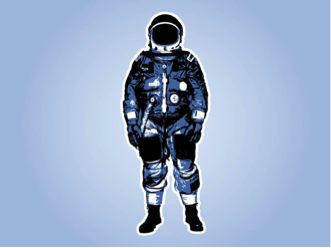Before donning the spacesuit, it is pressure tested by attaching the myriad components together, just as if the person was inside. The suit is pressurized above the ambient pressure of the room. Then, as the arms, legs, and torso are bent and twisted around; the pressure gauge on the left sleeve is examined for abnormalities. Any drop in pressure will be a ‘NO GO’ on that particular suit until repairs can be made. Submersion testing while pressurized was performed on all suits prior to launch, but leaks have a way of developing when you least expect them. Each member of the crew has a set of five identical suits which are all constructed with interchangeable components so that a faulty helmet from one may be switched with the helmet of another, or pants for pants, and so on.
To begin the process of entering the suit, Carl slipped on the boot liners. These are sort of a felt-like material, designed not so much for cushioning the feet, but to wick perspiration away from the body. Due to the rigorous activities involved, Gemini and Apollo astronauts had been known to lose several pounds of water-weight during a single EVA. That is why the boot liners provide a way to trap perspiration and the suit has a canteen to prevent dehydration.
After that, come the pants with attached boots, which eliminate two connection points where air might leak. This is followed by the top, which locks to the pants by means of an airtight fitting, which twists and snaps into place like changing the lens on a camera.
Then, the gloves are pulled on. These too have a similar fitting that locks to the sleeves at the wrists. The last piece of the outer suit is the helmet. On the surface of Mars, the racing stripe model will be used. But for deep space, a slightly larger model is better suited to the task. It features a clear faceplate behind an adjustable gold visor to aid in blocking out the much more intense sunlight, unfiltered by an atmosphere.

